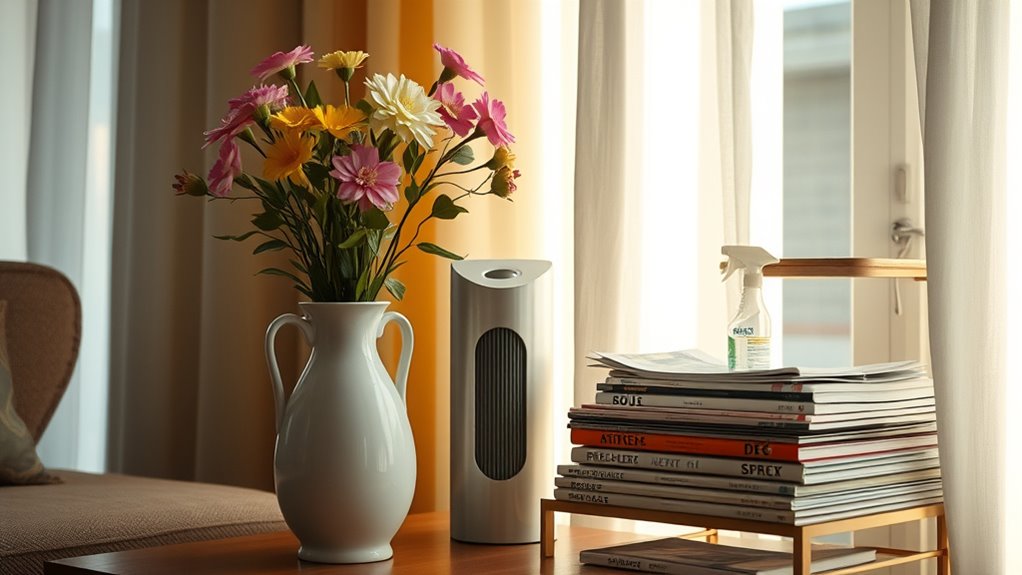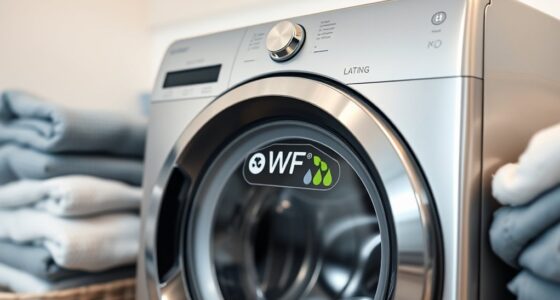Many everyday household items pollute your indoor air without you realizing it. Air fresheners, scented candles, and cleaning products release harmful VOCs and chemicals that can cause health issues over time. Personal care items may contain hormone-disrupting ingredients. Non-stick cookware and damaged coatings can leach toxins, while mold, mildew, and VOC-laden carpets add to the exposure. Pesticides and insecticides indoors can also pose long-term health risks. Keep going to discover simple ways to make your home safer.
Key Takeaways
- Air fresheners, scented candles, and cleaning products release VOCs and hazardous chemicals that can pollute indoor air.
- Non-stick cookware and damaged Teflon coatings can emit toxic fumes and leach harmful chemicals into food.
- Pesticides and insecticides contain chemicals that pose health risks through inhalation, skin contact, and residue buildup.
- Mold and mildew grow in damp areas, releasing spores that can harm respiratory health if humidity isn’t controlled.
- Personal care items with synthetic fragrances and chemicals may disrupt hormones and cause long-term health issues.
Air Fresheners and Scented Candles

Have you ever wondered what’s really in those air fresheners and scented candles filling your home? Many of these products emit chemical emissions that can harm indoor air quality. They often contain synthetic fragrances designed for scent masking, which can hide unpleasant odors but introduce hazardous chemicals. When you light a scented candle or spray an air freshener, you might be exposing yourself to volatile organic compounds (VOCs) and other pollutants. These chemicals can cause headaches, respiratory issues, or allergic reactions over time. Despite their pleasant smell, these products don’t just mask odors—they release toxins into your environment. Being aware of this allows you to choose safer alternatives or reduce your reliance on products that contribute to indoor pollution. Additionally, opting for natural air purification methods can help improve indoor air quality without introducing harmful chemicals.
Cleaning Products and Detergents

Many cleaning products and detergents contain chemicals that can pollute indoor air and pose health risks. These synthetic cleaners often release volatile organic compounds (VOCs) that irritate your lungs and skin. To reduce exposure, consider switching to natural cleaning methods. DIY solutions using vinegar, baking soda, and lemon are effective, affordable, and free of harmful chemicals. You can easily make all-purpose cleaners at home that tackle dirt without compromising your health. Look for plant-based or eco-friendly brands if you prefer store-bought options. Regularly ventilate your space when cleaning, and avoid aerosol sprays that disperse toxins into the air. Small changes like these can substantially improve your indoor air quality and create a safer, healthier environment for you and your family. Incorporating non-toxic cleaning products can further enhance your efforts to maintain a healthier home.
Personal Care Items With Harmful Chemicals

Just as harmful chemicals in cleaning products can affect your indoor air quality, personal care items often contain ingredients that can jeopardize your health. Many skincare and beauty products include ingredient risks like parabens, phthalates, and synthetic fragrances, which have been linked to hormone disruption and other health issues. Unfortunately, ingredient regulation varies widely, and some harmful substances slip through safety checks. When you use lotions, shampoos, or makeup, you’re exposing yourself to chemicals that may accumulate over time. It’s essential to read labels carefully and choose products with fewer synthetic ingredients or those labeled as free from harmful chemicals. Being aware of ingredient risks and supporting stricter regulation can help you reduce your exposure and protect your well-being. Additionally, awareness of Pimple Patch technology can guide you toward safer, more effective skincare options.
Non-Stick Cookware and Teflon Coatings

Non-stick cookware coated with Teflon can release toxic fumes if overheated, posing health risks to anyone nearby. When Teflon breaks down at high temperatures, it emits fumes containing chemicals linked to flu-like symptoms and respiratory issues. Additionally, non-stick chemical leaching can occur over time, especially with scratched or damaged coatings, introducing harmful substances into your food. To understand this better, consider the table below:
| Issue | Cause | Health Impact |
|---|---|---|
| Teflon breakdowns | Overheating past 500°F | Toxic fumes, respiratory problems |
| Chemical leaching | Worn or damaged coatings | Exposure to harmful chemicals |
| Long-term use | Repeated use over years | Accumulation of toxins in food |
Avoid overheating your non-stick pans, replace damaged cookware, and consider alternative materials to reduce your exposure to these pollutants. Regularly inspecting your cookware for coating integrity can help prevent unexpected chemical exposure.
Mold and Mildew in Damp Spaces

Have you noticed musty odors or visible black spots in your bathroom or basement? These signs often indicate mold or mildew growth in damp spaces. To prevent mold, focus on mold prevention techniques like fixing leaks and improving airflow. Humidity control is key—you should keep indoor humidity below 60%, ideally around 30-50%, using dehumidifiers or ventilation fans. Regularly clean affected areas with mold-killing solutions, and dry them thoroughly after showers or spills. Avoid clutter that traps moisture, and ensure good air circulation. Mold and mildew thrive in moist environments, so maintaining low humidity and addressing leaks quickly can considerably reduce their growth. Staying vigilant about damp spaces helps keep your home healthier and mold-free. Additionally, understanding environmental factors like humidity levels can help you better manage and prevent mold growth.
Carpets and Upholstery With VOCS

Carpets and upholstery can release volatile organic compounds (VOCs) into your home’s air, especially when new or cleaned with chemical-based products. This process, known as material off gassing, contributes to VOC emissions that can linger for weeks or even months. These emissions can cause headaches, respiratory irritation, and other health issues over time. When you walk on or sit on these surfaces, you may unknowingly breathe in these harmful chemicals. To reduce exposure, opt for carpets and upholstery made from natural, low-VOC materials and choose non-toxic cleaning products. Regular ventilation helps dissipate VOCs faster. Being aware of how your furniture contributes to indoor pollution allows you to make better choices for a healthier living environment. Additionally, choosing VOC-absorbing materials can help further reduce indoor air contamination.
Pesticides and Insecticides Used Indoors

Indoor pesticides and insecticides can leave residues that linger in your home, often unnoticed. These chemicals may pose health risks, especially with prolonged exposure. Understanding their impact helps you make safer choices for your living environment. Additionally, some common household items, like self watering plant pots, can also contribute to indoor pollution if not properly maintained.
Indoor Pesticide Residues
Many households rely on pesticides and insecticides to keep pests at bay, but these chemicals often linger as residues on surfaces and in the air. Indoor application of pesticides can leave behind persistent pesticide residues that you might not see or smell but can still affect your health. These residues settle on furniture, floors, and countertops, creating continuous exposure. To visualize this, consider the following:
| Surface Type | Pesticide Residues | Potential Exposure Risk |
|---|---|---|
| Kitchen Counter | High | Food contamination |
| Carpets | Moderate | Airborne particles |
| Furniture | Low | Skin contact |
Regular cleaning and choosing natural pest control methods can help reduce indoor pesticide residues, making your home safer. Additionally, understanding the persistence of chemical compounds in pesticides can help you make better choices for a healthier environment.
Health Risks From Insecticides
Although insecticides effectively control pests, they can pose significant health risks when used indoors. Exposure to these chemicals is a health hazard that can affect your nervous system, cause respiratory issues, or trigger allergic reactions. When you spray or apply insecticides, you’re at risk of chemical exposure, which can linger in the air or settle on surfaces. Children, pregnant women, and pets are especially vulnerable to the harmful effects. Frequent or improper use increases the chance of absorbing toxins through your skin, inhalation, or ingestion. Even residual pesticides left behind after application can contribute to long-term health problems. To protect yourself, limit indoor insecticide use and consider natural alternatives, reducing your risk of chemical exposure and safeguarding your health. Understanding the health risks of pesticides is vital for making informed choices about pest control methods.
Frequently Asked Questions
Are There Natural Alternatives to Air Fresheners and Scented Candles?
Looking for natural alternatives to air fresheners and scented candles? You can try natural remedies like simmering herbs, citrus peels, or spices to freshen your space. Essential oils are a great option; diffusing lavender or eucalyptus can create a pleasant aroma without harmful chemicals. These natural remedies are safer and eco-friendly, helping you enjoy a fresh, clean home while avoiding pollutants often found in commercial products.
How Can I Identify Harmful Chemicals in Cleaning Products?
Imagine uncovering hidden dangers lurking in your cleaning supplies. To spot harmful chemicals, start by carefully reading chemical labels and ingredient lists. Look for unfamiliar or long chemical names, and avoid products with labels that hide ingredients under vague terms like “fragrance” or “special additives.” Trust your instincts—choose products with clear, natural ingredients, and consider researching unfamiliar chemicals online to guarantee your home stays safe and toxin-free.
Which Personal Care Items Are Safest for Sensitive Skin?
You want safe options for sensitive skin, so look for hypoallergenic moisturizers and fragrance-free lotions. These products avoid common irritants like artificial fragrances and dyes, reducing your risk of allergic reactions. Always check labels to verify they’re free from harsh chemicals. Choosing gentle, dermatologist-recommended products helps you maintain healthy skin without exposing yourself to unnecessary toxins, making your skincare routine safer and more comfortable daily.
What Are the Health Risks of Non-Stick Cookware?
Non-stick cookware can pose health risks due to chemical leaching, especially with long-term exposure. When heated at high temperatures, the non-stick coating releases harmful chemicals that may affect your liver, kidneys, and immune system. Over time, these chemicals can accumulate in your body, increasing the risk of certain health issues. To protect yourself, consider using alternatives like stainless steel or cast iron, especially for frequent cooking.
How Can I Effectively Remove Indoor Mold and Mildew Safely?
To effectively remove indoor mold and mildew safely, start by addressing moisture control—repair leaks and use dehumidifiers. Clean affected areas with a mixture of water and mild detergent or white vinegar, then scrub thoroughly. Improve air filtration by using HEPA air purifiers to capture mold spores, and guarantee good ventilation. Regularly clean and monitor humidity levels to prevent future growth, keeping your home healthier and mold-free.
Conclusion
By choosing natural alternatives, improving ventilation, and being mindful of what you bring inside, you can reduce your home’s pollution. Stop using harsh chemicals, avoid synthetic fragrances, and regularly clean to prevent mold. Focus on safer cleaning, safer living, and safer choices. Your home should be a sanctuary, not a source of toxins. Take control, make conscious decisions, and breathe easier—because a healthier home starts with you.









